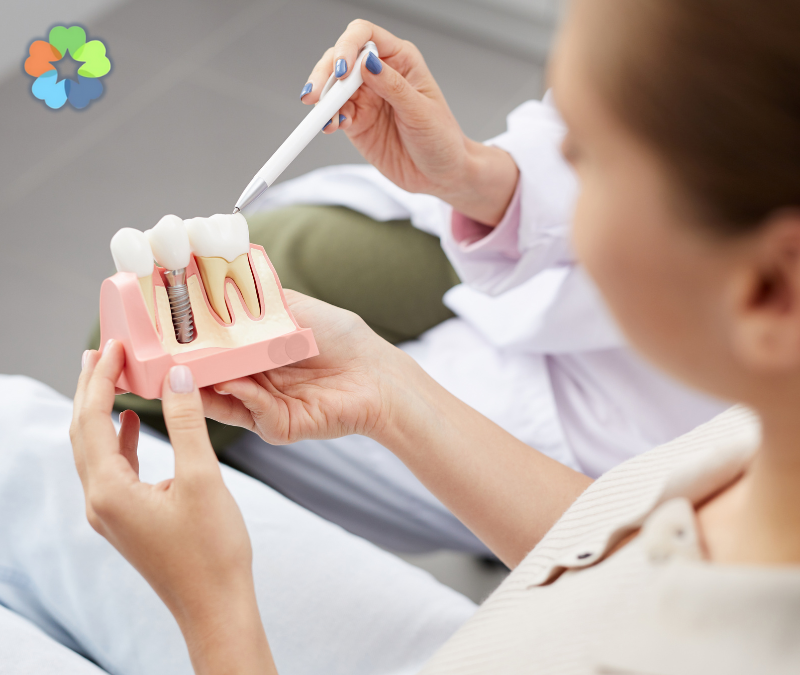Dental implants have revolutionized tooth replacement options for our patients at Blossom Dental Centre. As a High River, Alberta dentist, I’m continually amazed by the incredible science behind these innovative devices. Additionally, knowing how dental implants integrate can allow you to understand why they’re often the ideal solution for missing teeth.
The Amazing Process of Osseointegration
Dental implants function because of an incredible biological process called osseointegration. During this process, your jawbone literally grows around and is bonded to the titanium implant post. Furthermore, this creates a permanent bond that replicates your natural tooth root structure.
When we place a dental implant, we’re actually providing your bone cells with a biocompatible scaffold. Additionally, your cells recognize the surface of titanium as a familiar substance rather than as a foreign entity. Thus, your bone tissue begins to grow directly onto and into the microscopic crests of the implant surface.
The healing time for osseointegration in its entirety is typically 3-6 months. Healing time varies among each patient as a function of such parameters as:
- General health condition and immune status
- Bone strength and density
- Smoking habit (which can significantly delay healing)
- Nutrition and vitamin D status
- Existence of certain medical conditions
- The Microscopic Magic Occurring in Your Jaw
What is so incredible about osseointegration is what happens at the cellular level. First, your body encapsulates the implant in a protein matrix. Second, specialized bone cells called osteoblasts migrate into this matrix. They then begin depositing calcium and other minerals to build new bone tissue.
We would observe, under a microscope, a highly developed ballet of cell movement. First, a clotting process creates a scaffolding for repair. Second, inflammatory cells sweep away the wreckage. And third, bone-forming cells arrive to begin reconstruction.
The titanium surface of the implants is instrumental in this procedure. In fact, titanium develops a fine layer of oxide when it comes into contact with oxygen. This creates the perfect interface upon which bone cells can bind. This creates an extremely strong implant-to-bone connection.
Why Your Body Accepts Dental Implants
You might wonder why your body does not reject dental implants as a foreign object. The reason lies in the high biocompatibility of titanium. In contrast to most materials, titanium barely triggers immune responses or inflammation when implanted in the human body.
This biocompatibility is the reason why titanium is used in many medical applications, including:
- Joint replacements
- Pacemakers
- Cranial plates
- Spinal fusion devices
In dental implants, though, the quality of titanium used is purposely selected for best osseointegration. And in addition to this, current implant surfaces are normally coated or texturized in some fashion to enhance the adhesion of bone cells.
Why Dental Implants Feel and Function Like Natural Teeth
Once osseointegration is achieved, dental implants are a stable platform that closely mimics the root of a natural tooth. This firm support to your jawbone allows your implants to guide forces of biting effectively. So, you can enjoy foods that are challenging with dentures.
The bone attachment to the implant also provides sensation feedback as natural teeth. You will not feel precisely the same as natural teeth in terms of nerve connections, but your brain adapts to sense pressure and temperature changes with the tissues.
Another significant advantage is bone preservation. When natural teeth are lost, the jawbone typically begins to shrink through a process called resorption. However, dental implants stimulate the bone during chewing, maintaining bone volume and density. Consequently, this helps preserve your facial structure and appearance over time.
The Three Components of a Dental Implant
A complete dental implant restoration consists of three parts:
- The implant post – The titanium “root” that osseointegrates with your jawbone
- The abutment – A connector piece that fits onto the implant
- The crown – The exposed part that is shaped and functionally identical to a natural tooth
This three-part system delivers both strength and beauty. Moreover, it leaves room for treatment planning and maintenance in the future if necessary.
Is Osseointegration Right for You?
At Blossom Dental Centre in High River, we carefully evaluate the appropriateness of every patient for dental implants. Most healthy adults with teeth and gums are eligible, but certain factors may affect osseointegration:
- Bone volume and density
- Gum condition
- Diabetes control
- Smoking
- Certain medications
- In a positive note, patients with bone loss tend to be eligible for implants after preparatory treatments like bone grafting. Furthermore, continuing innovations in implant design and surgery are widening the number of eligible candidates.
If you’re considering dental implants, I invite you to schedule an appointment for a consultation at our High River clinic. We’ll collaborate to determine if this fantastic tooth replacement option is the perfect fit for you. Call today at 825-212-0406 to begin your journey to a complete, healthy smile.

